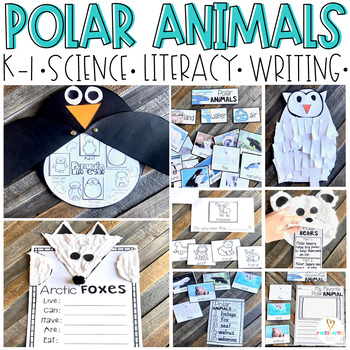Polar Animal Activities (Arctic Animals) 20+ Sorting, Writing & Printables) K-1
- PDF
What educators are saying
Also included in
- Are you looking for fun and educational centers and activities for your science and literacy centers? Then, Science Bundles are for you! Currently in this bundle is Hibernation, Plants and Ponds. Coming in the next few weeks is " Polar Animals. This unit will be home of any future science units.Price $60.00Original Price $82.00Save $22.00
Description
Are you looking for a factual unit to introduce polar animals and arctic animals in your kindergarten or first grade classroom? Our Polar Animal Activities for Literacy and Science unit is just what you need! It has over 20 sorting, comprehension, writing and opinion printables and activities.
This unit is also included in our Science Bundle.
❤️This unit includes:❤️
•21 Real Photos of Polar Animals
•Sorting Labels
•How do Polar Animals Adapt Large Group Book
•Comprehension Pages
•Pick 3 (Draw and Write a Fact for 3 Polar animals)
•Polar Animal Labeling (3 different Pages)
•Polar Animals Making a List (alphabetical order and listing favorite polar animals)
•Polar Animal Word Search
•Polar Animal Informational Writing (2 levels-choose one animal to focus and write about)
•Polar Animal Clue Game (Large Group Activity)
•Polar Animal favorites Large Group Sort and Writing Activity
•Study Focus on 6 Different Polar animals: Polar Bears, Harp Seal, Walrus, Penguins, Arctic Fox and •Snowy Owl. Each animal will have the following:
•Non-Fiction Passages
•Interactive Fact Pages
•Comprehension/Question and Answer (2 Different Levels)
•Can, Have & Are Anchor Charts (Large Group)
•Can, Have & Are Follow Along (with answer key)
•Brainstorming Maps
•Sentence Writing and Building
•Polar Bear Fact Craft
•Walrus Craft and Facts
•Arctic Fox-Can, Have, Are Craft
•Harp Seal-Can, Have, Are Craft
•Penguin Life Cycle Craft
•Penguins-Parts of a Story Craft
•Snowy Owl Fact Craft
Click {HERE} to check out the BLOG post.
Are You looking for more science units?
Ocean
❄️Kindergarten Winter Favorites❄️
Editable Sight Words Games Winter
January Math and Literacy Printables and Digital Cards
More Kindergarten Ideas:
Editable Sight Word Games Bundle
Color by Primer Sight Word Bundle
Color by Code Math and Literacy Bundle
Math and Literacy Bundle for the Year
(C) Kindergarten Rocks 2016-Present






